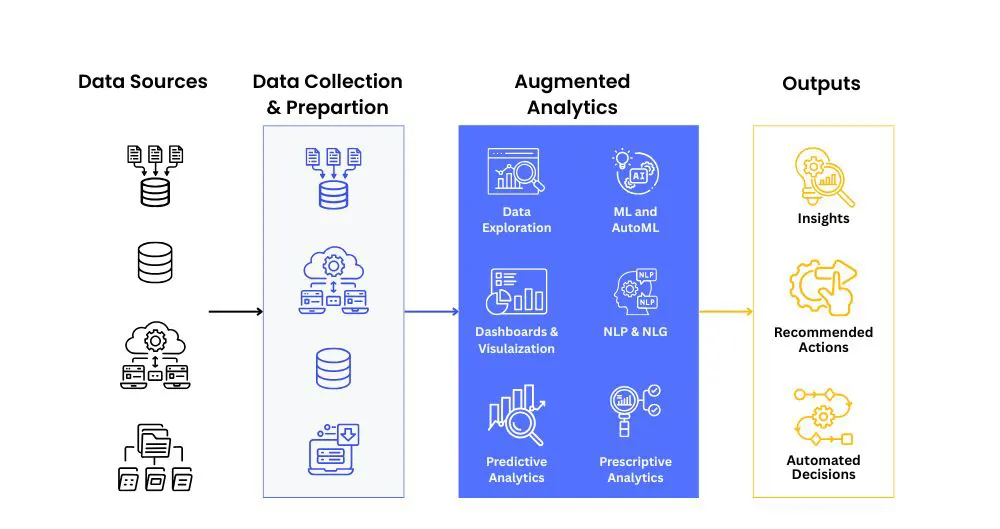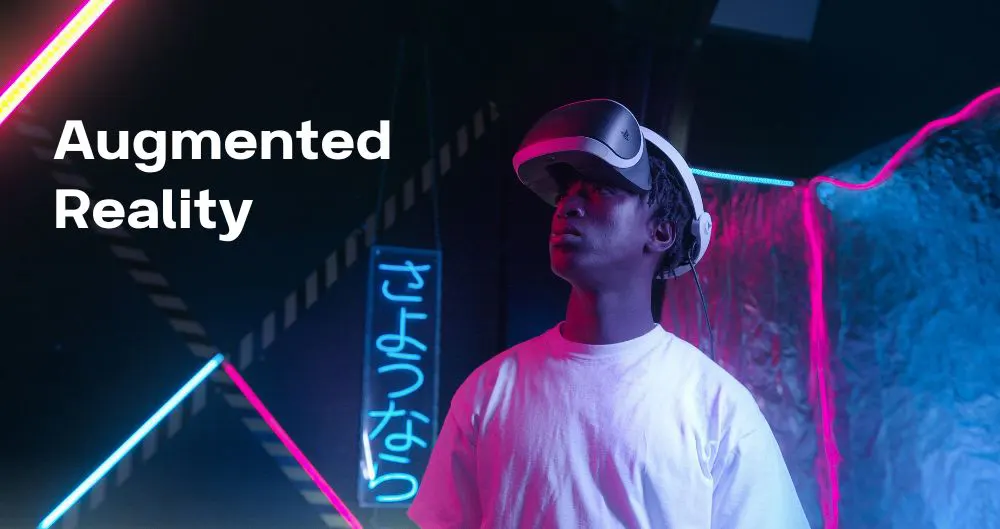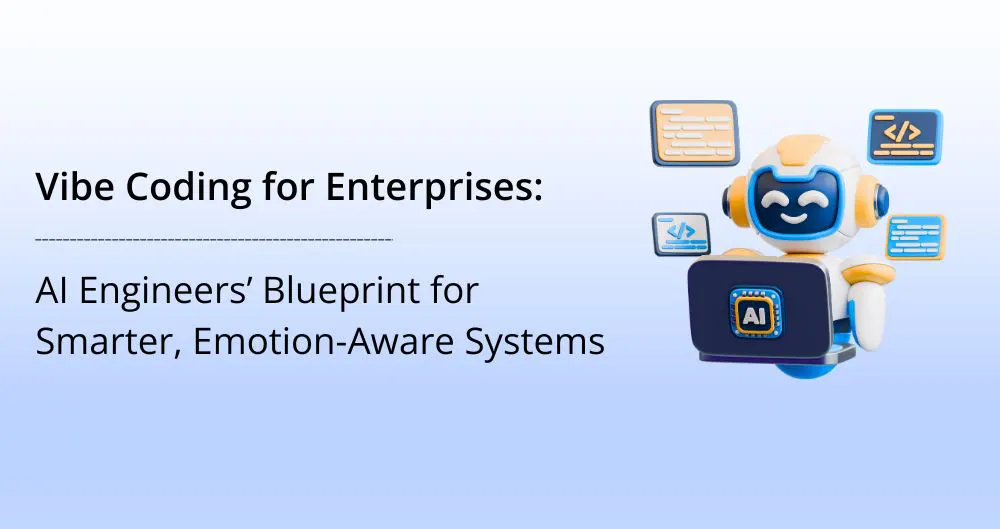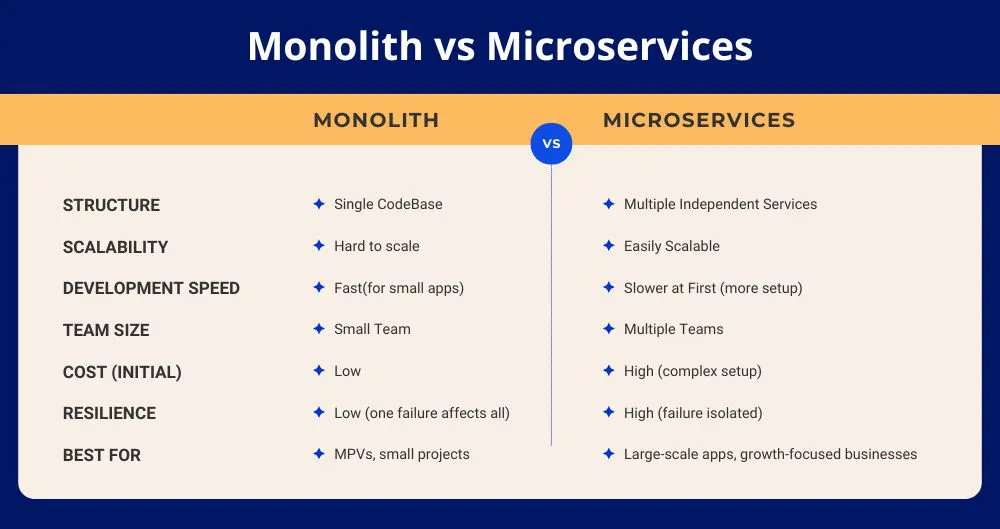May 1, 2025
Highlights
Data is now as essential as air, surrounding us everywhere. Every manager, employee, and business user must be able to absorb it, analyze its components, and use it to guide their decision-making. What’s crucial is the ability to do this swiftly and naturally to seize fleeting opportunities.
Augmented analytics simplifies the process for data scientists to uncover groundbreaking insights, while also speeding up decision-making for those without a data background. With predictions that 50% of business decisions will be augmented or automated by AI agents by 2027, early adopters are poised to gain the most significant benefits.

Augmented Analytics: What It Is and How It Outperforms Traditional Analytics
Augmented analytics uses AI and machine learning to simplify data analysis, reduce manual work for data teams, and offer personalized insights based on user roles, preferences, and behavior. It also automatically handles complex tasks like forecasting and model building.
Unlike traditional analytics, augmented tools don’t just follow commands—they predict your needs based on patterns over time, offering insights you didn’t even know you needed. This approach relies on:
- Machine Learning: The backbone of augmented analytics, driving automation and enabling advanced functions like predictive analytics.
- Conversational AI: Using natural language processing and generation to turn complex data into clear, actionable insights and offer proactive suggestions.
- Automation: Streamlining routine tasks such as data preparation, cleaning, and integration, making the process more efficient.
Augmented Analytics Evolves: Introducing Agentic Analytics
Augmented analytics has recently merged with AI agents—programs that can autonomously perform tasks. While augmented analytics enhances human decision-making, agentic analytics goes further by proactively identifying problems, suggesting solutions, and even taking action with minimal human input.
Agentic analytics tools can also access external data beyond their initial training to handle complex, multi-step tasks.
See Augmented Analytics Software in Action
Your business software—CRM, accounting systems, ERP—captures real-time data that could drive cost savings and profit growth. But traditional analytics tools make it hard for most users to take advantage of this data. Augmented analytics, powered by AI changes that.Automating Data Management
For data to become valuable insights, it must be cleaned and properly formatted. However, with data coming from various sources in different formats, it can take days for your analytics team to organize it before they can begin analysis.
Augmented analytics streamlines this process with automation throughout the data lifecycle:
- Automatically collects and identifies data from complex sources, detecting different data types and outliers.
- Cleans and prepares data by filling in missing values, removing duplicates, and handling outliers.
- Organizes and clusters data, identifying patterns, trends, and segments.
- Uncovers hidden connections, generates hypotheses, and builds predictive models autonomously.
Making Data Accessible to All
Every business faces three key questions: What happened? Why? What’s next? Traditional analytics with its steep learning curve makes it tough for most to find answers. Not everyone has the skills in statistical methods or SQL. With augmented analytics, users can simply ask questions in plain English. The built-in NLP engine translates these queries, making insights more intuitive and accessible. For example, instead of writing complex queries, a user can simply ask, “What were our sales in Q3?” and the system will provide the breakdown.How Augmented Reality Works?

“
— Shehzad Ali, AI Lead Engineer, Techzooni
What Augmented Analytics Offers That BI Can’t
While traditional BI tools enable users to analyze data, augmented analytics tools go a step further by helping users understand the data, regardless of their technical expertise.
| Feature | Augmented Analytics Platforms | Business Intelligence Platforms |
|---|---|---|
| User Proficiency | Accessible to business users with no coding or statistical knowledge required | Requires technical experts (analysts, data scientists) |
| Data Exploration | Enables free-form data exploration with natural language processing and AI-powered guidance | Relies on pre-defined reports and dashboards |
| Insights Generation | Automated discovery of insights, patterns, anomalies, and trends | Manual, time-consuming process |
| Data Preparation | Automated data preparation and cleansing | Extensive data modeling and preparation required |
| Output Format | Static reports, charts, and dashboards | Interactive visualizations, narratives, and recommendations |
“AI will transform the way we work and the way we live, but the true power lies in how we use it to solve the world’s most pressing challenges.”
— Ginni Rometty, Former CEO of IBM
Who Benefits from Augmented Analytics?
Augmented analytics enhances, rather than replaces, human judgment by automating tasks like data collection, analysis, and insight explanation, allowing people to focus on strategic decision-making.
– Business users, such as marketing teams, can quickly gain insights and improve their data literacy without needing technical expertise, enabling them to take action faster. For example, they can track social media sentiment and website traffic to evaluate campaign performance.
– Executives can directly query augmented analytics platforms to access sales trends, conversion rates, and campaign performance, instead of relying on reports from other departments.
– Data analysts can speed up their work by automating time-consuming tasks like data prep, model building, and report generation.
For example, a wealth management firm reduced customer churn analysis from months to days with a custom augmented analytics solution, freeing up time for more strategic initiatives. Data prep time dropped from weeks to minutes.
AI: The Future of Business Intelligence
In the face of economic challenges, companies that can quickly convert data into actionable insights won’t just survive—they’ll thrive. This makes augmented analytics one of the most crucial capabilities for top performers. However, while the benefits of augmented analytics are clear, adopting the technology isn’t as simple as flipping a switch. It’s just one piece of the puzzle. The real challenge lies in building the required technical expertise and updating the organization’s AI governance strategy.Frequently Asked Questions
1. What is augmented data analysis?
2. What is an example of augmented analytics?
Examples of augmented analytics include automated demand forecasting driven by natural language queries like, “Predict the demand for our flagship product next quarter, based on the upcoming marketing campaign.” Other examples are smart data profiling, automated data integration, and automated data discovery, among others.
Table of Contents
- Highlights
- Augmented Analytics: What It Is and How It Outperforms Traditional Analytics
- Augmented Analytics Evolves: Introducing Agentic Analytics
- See Augmented Analytics Software in Action
- How Augmented Reality Works?
- What Augmented Analytics Offers That BI Can’t
- Who Benefits from Augmented Analytics?
- AI: The Future of Business Intelligence
- Frequently Asked Questions
- Related Articles
- Vibe Coding for Enterprises: AI Engineers’ Blueprint for Smarter, Emotion-Aware Systems
- Microservices vs Monolith: Which Architecture is Right for Your Project?
- Avoiding Pitfalls: Why Enterprise Projects Fail and How to Stop It

Why Trust Techzooni?
Choose Techzooni for Augmented Reality because we bring innovation to life. Our cutting-edge AR solutions transform your business operations, streamline processes, and elevate customer experiences — all while driving efficiency and reducing costs. Experience the future today with Techzooni!
Step into the Future of Health Insurance with Augmented Reality. Faster Claims. Smarter Solutions. Better Service.
Related Articles
Vibe Coding for Enterprises: AI Engineers’ Blueprint for Smarter, Emotion-Aware Systems
Imagine a future where building software feels a bit like having a conversation. You tell your system what you want in plain English. Behind the scenes, intelligent agents spin up code, run tests, refactor, and even suggest improvements. That’s the world of vibe...
Microservices vs Monolith: Which Architecture is Right for Your Project?
Imagine that you’re opening a new restaurant. You could either rent one big hall where the kitchen, storage, and dining all happen in the same space—or you could design separate sections: a kitchen, a pantry, a dining area, and a drive-thru. Both setups can serve...
Avoiding Pitfalls: Why Enterprise Projects Fail and How to Stop It
Every successful software project starts with one key step: understanding why so many others fail. Large-scale enterprise initiatives are ambitious, but they often run into hurdles that derail progress. Research from Deloitte shows just how common this is. Among...



